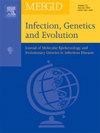广东省鹅星状病毒的分子检测与鉴定
IF 2.6
4区 医学
Q3 INFECTIOUS DISEASES
引用次数: 0
摘要
鹅星状病毒(Goose Astrovirus, GAstV)近年来已成为中国鹅类的主要病原体,主要危害鹅类,临床表现为痛风、脏器尿酸沉积等。值得注意的是,鸭子也出现了类似的症状。从2023年到2024年,从广东省的鸭子身上采集了126份肝脏样本,那里的农场报告了消瘦、瘫痪和死亡。宏基因组分析确定GAstV为原发病原体,qPCR阳性率为43.65%。鉴定出一株新菌株GD2406,与GenBank中的30株GAstV-2相似度为97.5% ~ 98.8%。GD2406与鸭株HNNY0620和SDTA的同源性分别为98.3%和97.7%,与高毒力GAstV株HNKF-1和HNSQ-6的同源性分别为98.3%和98.4%。系统发育分析表明,GD2406与鹅株HB01具有亲缘关系。共有13个氨基酸突变,主要发生在ORF2内,且有1个突变与HNKF-1和HNSQ-6不同,提示鸭和鹅具有显著的致病潜力。本研究首次报道了在广东省引起鸭类严重症状和死亡的GAstV,提示鸭类可能是主要宿主,并强调了跨物种传播的风险。本文章由计算机程序翻译,如有差异,请以英文原文为准。
Molecular detection and identification of goose astrovirus in GuangDong Province, China
In recent years, Goose Astrovirus (GAstV) has become a major pathogen in China, afflicting geese with significant clinical manifestations like gout and urate deposits in organs. Notably, similar symptoms have emerged in ducks. From 2023 to 2024, 126 liver samples were collected from ducks in Guangdong Province, where farms reported emaciation, paralysis, and deaths. Metagenomic analysis pinpointed GAstV as the primary pathogen, with a 43.65 % confirmed positive rate via qPCR. A new strain, GD2406, was identified, showing 97.5 %–98.8 % similarity to 30 GAstV-2 strains in GenBank. GD2406 displayed 98.3 % and 97.7 % identity with the duck strains HNNY0620 and SDTA, and 98.3 % and 98.4 % identity with highly virulent GAstV strains HNKF-1 and HNSQ-6. Phylogenetic analysis indicated a genetic closeness between GD2406 and the goose strain HB01. There were 13 amino acid mutations, mainly within ORF2, and a single mutation differing from HNKF-1 and HNSQ-6, hinting at significant pathogenic potential for both ducks and geese. This study is the first to report GAstV causing severe symptoms and mortality in Muscovy ducks in Guangdong Province, suggesting ducks could be key hosts and underscoring the risk of cross-species transmission.
求助全文
通过发布文献求助,成功后即可免费获取论文全文。
去求助
来源期刊

Infection Genetics and Evolution
医学-传染病学
CiteScore
8.40
自引率
0.00%
发文量
215
审稿时长
82 days
期刊介绍:
(aka Journal of Molecular Epidemiology and Evolutionary Genetics of Infectious Diseases -- MEEGID)
Infectious diseases constitute one of the main challenges to medical science in the coming century. The impressive development of molecular megatechnologies and of bioinformatics have greatly increased our knowledge of the evolution, transmission and pathogenicity of infectious diseases. Research has shown that host susceptibility to many infectious diseases has a genetic basis. Furthermore, much is now known on the molecular epidemiology, evolution and virulence of pathogenic agents, as well as their resistance to drugs, vaccines, and antibiotics. Equally, research on the genetics of disease vectors has greatly improved our understanding of their systematics, has increased our capacity to identify target populations for control or intervention, and has provided detailed information on the mechanisms of insecticide resistance.
However, the genetics and evolutionary biology of hosts, pathogens and vectors have tended to develop as three separate fields of research. This artificial compartmentalisation is of concern due to our growing appreciation of the strong co-evolutionary interactions among hosts, pathogens and vectors.
Infection, Genetics and Evolution and its companion congress [MEEGID](http://www.meegidconference.com/) (for Molecular Epidemiology and Evolutionary Genetics of Infectious Diseases) are the main forum acting for the cross-fertilization between evolutionary science and biomedical research on infectious diseases.
Infection, Genetics and Evolution is the only journal that welcomes articles dealing with the genetics and evolutionary biology of hosts, pathogens and vectors, and coevolution processes among them in relation to infection and disease manifestation. All infectious models enter the scope of the journal, including pathogens of humans, animals and plants, either parasites, fungi, bacteria, viruses or prions. The journal welcomes articles dealing with genetics, population genetics, genomics, postgenomics, gene expression, evolutionary biology, population dynamics, mathematical modeling and bioinformatics. We also provide many author benefits, such as free PDFs, a liberal copyright policy, special discounts on Elsevier publications and much more. Please click here for more information on our author services .
 求助内容:
求助内容: 应助结果提醒方式:
应助结果提醒方式:


